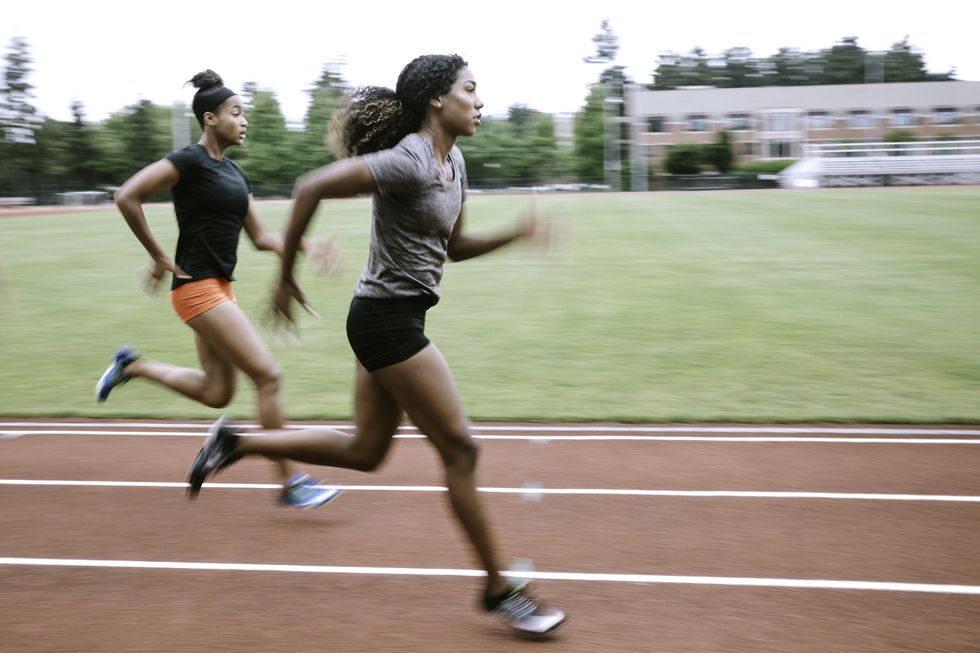Running a mile is a common goal for many people. But how long it takes can really depend on the person. Some might zoom through it in just a few minutes, while others might take a bit longer. It’s all about how fast you run, your fitness level, and even the day’s weather. In this post, we’ll look into what affects your mile time and what you can expect.

Contents
- 1 How Long Does It Take To Run A Mile?
- 2 How to Improve Your Mile Time?
- 3 Benefits of Running
- 4 Frequently Asked Questions
- 4.1 What factors influence mile run times?
- 4.2 How can being physically fit impact mile running?
- 4.3 Does age play a role in mile run performance?
- 4.4 How does weight affect mile running?
- 4.5 What role does gender play in mile run performance?
- 4.6 Why is experience in running important for mile times?
- 4.7 How do environmental conditions impact mile running?
- 4.8 How can training intensity affect mile times?
How Long Does It Take To Run A Mile?
The time it takes to run a mile varies greatly among individuals, influenced by factors such as running speed, fitness level, age, gender, and even environmental conditions. Let’s break down these factors to understand how they can affect your mile time and provide some calculations to help estimate your own pace.
Running Speed:
The most direct factor affecting how long it takes to run a mile is your running speed. Running speed is typically measured in minutes per mile and can range widely among runners.
- Beginners might run at a pace of 10 to 12 minutes per mile or slower.
- Intermediate runners often fall into the 7 to 9 minutes per mile range.
- Advanced runners can achieve times of less than 6 minutes per mile.
Fitness Level:
Your level of fitness has a significant impact on your running speed and endurance. Regular training can improve both, leading to faster mile times. A well-conditioned runner can maintain a faster pace with less effort compared to someone who is less fit.
Age and Gender:
Age and gender also play roles in determining mile times. Generally, runners reach their speed peak in their late teens to early 30s. After this peak, running times may gradually increase. Men, on average, tend to run faster than women due to differences in body composition and muscle mass, though individual performance can vary widely.

Environmental Conditions:
The conditions under which you run can affect your time. Running in hot, humid weather can slow you down, as your body works harder to cool itself. Conversely, cool, but not cold, weather can help improve your times. The terrain matters too; running uphill will slow you down, while downhill segments can speed you up.
Calculating Your Time:
To calculate how long it might take you to run a mile, you can use your running speed. If you know your pace (in minutes per mile), simply apply that pace to one mile. For example:
- If you run at a pace of 8 minutes per mile, it will take you 8 minutes to run a mile.
- If you’re unsure of your pace, you can estimate it based on your fitness level and experience, or time yourself over a mile.
Practical Example:
Suppose you’re a beginner runner and you start with a pace of 11 minutes per mile. With consistent training, you might improve your pace to 9 minutes per mile over several months. Therefore, initially, it takes you 11 minutes to run a mile, but with improvement, it could take 9 minutes.
How to Improve Your Mile Time?
Improving your mile time requires dedication, smart training, and attention to various factors. Here are some effective strategies:

Training:
- Follow a structured training plan: Plans can incorporate interval training, tempo runs, recovery runs, and hill repeats to challenge different aspects of your fitness. Many websites and apps offer free or paid plans based on your goals and experience level.
- Incorporate speed drills: Drills like high knees, butt kicks, and bounding can improve your running form and efficiency.
- Run at different paces: Don’t just stick to one pace. Varying your speed helps develop different energy systems and build overall endurance.
- Strength training: Strong core and leg muscles improve running form, power, and reduce injury risk. Include bodyweight exercises or weight lifting in your routine.
Other Tips:
- Improve your running form: A coach or experienced runner can analyze your form and suggest corrections to minimize energy expenditure and maximize efficiency.
- Get enough sleep: Sleep deprivation negatively impacts performance and recovery. Aim for 7-8 hours of quality sleep each night.
- Stay hydrated: Proper hydration is crucial for optimal performance and prevents fatigue. Drink plenty of water throughout the day and before, during, and after runs.
- Fuel your body right: Eat a balanced diet rich in fruits, vegetables, whole grains, and lean protein. Prioritize carbohydrates for energy and don’t neglect protein for muscle recovery.

- Consider wearing proper shoes: Invest in well-fitting running shoes designed for your gait and training type.
- Warm up and cool down: Before each run, perform dynamic stretches and light cardio to prepare your muscles. After your run, static stretches help prevent soreness.
- Listen to your body: Take rest days when needed and don’t push yourself through pain. Overtraining can lead to injuries and hinder progress.
- Stay motivated: Set achievable goals, find running buddies, track your progress, and celebrate your achievements to stay motivated.
Benefits of Running
Running offers a myriad of benefits for both your physical and mental health. Here are some of the key advantages you can enjoy by incorporating this activity into your life:

Physical Benefits:
- Cardiovascular Health: Running strengthens your heart and improves circulation, reducing the risk of heart disease, stroke, and high blood pressure.
- Weight Management: It burns calories effectively, aiding in weight management or preventing weight gain.
- Musculoskeletal Strength: Running builds stronger muscles, especially in your legs, core, and glutes, improving balance, stability, and posture.
- Bone Health: Regular running can help increase bone density, reducing the risk of osteoporosis.
- Improved Endurance: Running increases your stamina and lung capacity, making you less tired during everyday activities.
- Reduced Risk of Chronic Diseases: It may help lower the risk of type 2 diabetes, certain cancers, and Alzheimer’s disease.
- Improved Sleep Quality: Regular exercise, including running, can promote deeper and more restful sleep.
Mental Benefits:
- Stress Relief: Running releases endorphins, natural mood-boosting chemicals that combat stress and anxiety.
- Reduced Depression and Anxiety: Exercise can be as effective as medication in managing symptoms of depression and anxiety.
- Increased Self-Esteem: Achieving running goals and witnessing your progress can boost your confidence and self-esteem.
- Improved Cognitive Function: Running can enhance memory, focus, and cognitive flexibility.
- Reduced Risk of Mental Decline: It may help protect against age-related cognitive decline and dementia.
- Sense of Accomplishment: Completing runs, big or small, provides a sense of accomplishment and satisfaction.
- Improved Mood and Well-being: Running can leave you feeling energized, happier, and more positive overall.
Frequently Asked Questions
What factors influence mile run times?
Several factors can influence mile run times, including fitness level, age, weight, gender, experience in running, environmental conditions, and training intensity.
How can being physically fit impact mile running?
Being physically fit can lead to faster mile times as it improves cardiovascular endurance, muscle strength, and overall stamina for running.
Does age play a role in mile run performance?
Yes, age can impact mile run performance. Generally, younger individuals tend to have faster mile times compared to older individuals due to better physical capabilities.
How does weight affect mile running?
Lower weight can contribute to faster mile times as it reduces the load on the body, making running more efficient and less strenuous.
What role does gender play in mile run performance?
Gender can influence mile run performance, with males often having faster times compared to females due to differences in muscle mass and overall body composition.
Why is experience in running important for mile times?
Experience in running can enhance performance by improving running technique, endurance, mental toughness, and pacing strategies.
How do environmental conditions impact mile running?
Favorable environmental conditions, such as moderate temperature, low humidity, and minimal wind resistance, can positively affect mile running performance.
How can training intensity affect mile times?
Intense training, which includes speed work, intervals, and endurance exercises, can boost cardiovascular fitness, speed, and endurance, resulting in faster mile times.

Hello, I’m Ravindra. Over the years, I’ve immersed myself deeply into the world of fitness and health, transforming both my body and mind. Writing has allowed me to share my journey, insights, and expertise with those just starting out and seasoned fitness enthusiasts alike. Beyond just routines and diets, I believe in inspiring others to adopt a holistic approach to well-being.
